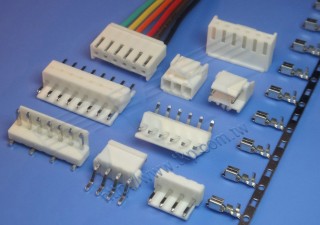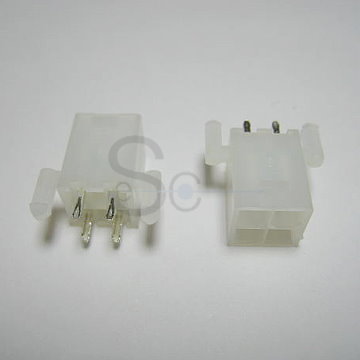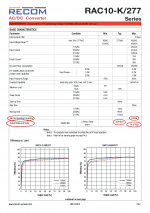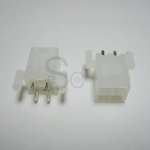I am planning some op-amp based projects that need both positive and negative supply rails, the usual 0V, +15V, -15V. I'd like to build these into little die-cast boxes of the sort used for guitar FX pedals.
To power these, I would like to find a suitable power connector that has (at least) three pins, is reasonably small and compact, can carry a reasonable amount of current - say 100 mA DC minimum - and which electrically isolates all three pins from whatever metal box the connector is mounted to. Oh yeah, if at all possible, it should be available at Digikey or Mouser.
Basically, I'm looking for a 3-pin replacement for the everyday 5.5mm "barrel jack" and "barrel plug" connectors we find on most of our contemporary small power supplies and the products they plug into.
I did find these ( https://www.digikey.com/products/en?mpart=1838839-1&v=17 ), but nearly $14 Canadian per connector is a bit much. Surely there is a less expensive alternative?
I also found these ( https://www.digikey.ca/product-detail/en/cui-inc/MD-30SN/CP-2530-ND/164868, https://www.digikey.ca/product-detail/en/cui-inc/MD-30/CP-2030-ND/96910 ). I think these are usable, but the plug is awkwardly long. Really long!
So I have had some trouble finding anything I really liked. Anyone have any suggestions for a suitable connector pair?
-Gnobuddy
To power these, I would like to find a suitable power connector that has (at least) three pins, is reasonably small and compact, can carry a reasonable amount of current - say 100 mA DC minimum - and which electrically isolates all three pins from whatever metal box the connector is mounted to. Oh yeah, if at all possible, it should be available at Digikey or Mouser.
Basically, I'm looking for a 3-pin replacement for the everyday 5.5mm "barrel jack" and "barrel plug" connectors we find on most of our contemporary small power supplies and the products they plug into.
I did find these ( https://www.digikey.com/products/en?mpart=1838839-1&v=17 ), but nearly $14 Canadian per connector is a bit much. Surely there is a less expensive alternative?
I also found these ( https://www.digikey.ca/product-detail/en/cui-inc/MD-30SN/CP-2530-ND/164868, https://www.digikey.ca/product-detail/en/cui-inc/MD-30/CP-2030-ND/96910 ). I think these are usable, but the plug is awkwardly long. Really long!
So I have had some trouble finding anything I really liked. Anyone have any suggestions for a suitable connector pair?
-Gnobuddy
It will work, but both the tip and ring get shorted to ground as you insert the plug. In principle you can make sure to only insert the plug when the power supply is unplugged (or off), but in practice you always forget sooner or later...then you find sparks and blackened metal on the plug and jack. And one day soon you have to replace the damaged and burned jack, then the damaged and burned plug, and then the power supply itself dies...Some guitar pedals (like Dod) are using 3.5mm mono jack for DC powering, by taking an isolated stereo jack maybe it would do.
(I have some small electronic doodads at work that supply DC power via a mono 3.5 mm jack and plug, so I see this problem frequently.)
Thank you for the suggestion, though, I appreciate it!
-Gnobuddy
DIN jack and plug like found on MIDI equipment or mini DIN like used on computer mouse before USB.
Just chose something other than 5 pin unless you have no MIDI equipment. It would suck to accidentally plug +/- 15 volts into the MIDI jack on something expensive like a synthesizer.
Unfortunately I have a Samson Mixpad 9 that uses a standard size 5 pin DIN plug on it's very large external power supply that sits in the middle of a bunch of MIDI synthesizers. I have wrapped its cord with bright red and yellow tape, but it would be really easy to do something STUPID with this setup. I think that Samson made a poor choice here.
Just chose something other than 5 pin unless you have no MIDI equipment. It would suck to accidentally plug +/- 15 volts into the MIDI jack on something expensive like a synthesizer.
Unfortunately I have a Samson Mixpad 9 that uses a standard size 5 pin DIN plug on it's very large external power supply that sits in the middle of a bunch of MIDI synthesizers. I have wrapped its cord with bright red and yellow tape, but it would be really easy to do something STUPID with this setup. I think that Samson made a poor choice here.
Thanks for all the suggestions! I appreciate the input.
I might settle for mini DIN or mini XLR. I don't use either of those connectors in any of my other equipment, so there is less chance of accidentally plugging in the wrong thing and frying expensive electronics.
Op-amps have been in tons of consumer gear since the 1970s. After nearly 50 years, I'm rather surprised that there doesn't seem to be some sort of standard consumer-grade 3-pin power connector for use with them.
-Gnobuddy
I might settle for mini DIN or mini XLR. I don't use either of those connectors in any of my other equipment, so there is less chance of accidentally plugging in the wrong thing and frying expensive electronics.
Op-amps have been in tons of consumer gear since the 1970s. After nearly 50 years, I'm rather surprised that there doesn't seem to be some sort of standard consumer-grade 3-pin power connector for use with them.
-Gnobuddy
Agree that all are good. I've had better experience with XLR: DINs wear with age and get tricky to plug in when old. I would use 3 pin XLR, but pick an unusual configuration to avoid confusing with signal connections. 4 pin XLR is still common in PA world, probably need to go 5 pin if you want to use that avoid mixed up cabling.
3 pin barrel connectors like on laptops are fine, but I would source from ebay, which you say you are unwilling to do.
3 pin barrel connectors like on laptops are fine, but I would source from ebay, which you say you are unwilling to do.
That was one of the options I had been thinking about. Then, quite recently I found this at Digikey: https://www.digikey.com/product-detail/en/recom-power/RAC10-15DK-277/945-3126-5-ND/7807874Another option for low powered stuff is to just use a single positive 15 volt supply and place a inverting converter inside the box.
How can you beat that? Small, cheap, light, super simple. Only five pins to deal with, two wired to AC mains, and the other three spit out regulated +/- 15V DC at up to 340 mA, for under $12 USD. Amazing!
So the plan is to build one of those into a box, with a little extra RC filtering, and then use it to power multiple op-amp based guitar projects, in the same way I use a single 9V power supply to run several of my store-bought guitar pedals.
It would have been nice if the guitar FX pedal industry had switched to +/- 15V DC power by now. The old 9V DC standard is really not quite enough voltage, as witnessed by several "boutique" pedals that have internal charge-pump circuitry to raise that to 18 volts.
Better to go all the way to 30 volts, and then you finally have a little headroom when building a circuit that is not supposed to clip. Like the speaker / cab emulation filter that's been on my mind lately.
-Gnobuddy
Thanks for the suggestion. These? CPC from Aircraft Spruce CanadaI've used aviation connectors for low voltage supplies
-Gnobuddy
Thanks for the suggestion!3 pin barrel connectors like on laptops are fine, but I would source from ebay, which you say you are unwilling to do.
Yeah, I don't use Ebay much...I bought some stuff from Ebay in the past, and found I hated the whole process of making a bid, waiting for days, and invariably getting outbid by someone who got auction fever and was willing to pay twice what the item was actually worth.
I once saw someone pay three times the brand-new purchase price to an Ebay seller for a set of quite ordinary Dodge automotive floor-mats. The same mats could be bought right at your local Dodge dealerships parts department.
After that I would only buy something if there was a "buy it now" price that was reasonable. That only happened once for every ten or so things I was interested in. So I just stopped using Ebay altogether. It's too frustrating.
-Gnobuddy
No, these aviation plugs | eBay
I've used both 16mm and 12mm. They are like the plugs on CB radio mics
I've used both 16mm and 12mm. They are like the plugs on CB radio mics
.... I have wrapped its cord with bright red and yellow tape, but it would be really easy to do something STUPID with this setup. I think that Samson made a poor choice here.
Yup. That's the trouble with reusing any "standard" connector that doesn't already have +/-15V DC. Especially there's no current limiting
The answer I usually end up with is either D-sub; "Molex" (automotive e.g. 172767-0014) or MIL-C (surplus or COTS equivalent) depending on the environment. All a bit more bulky than you'd like
But I'd suggest half an hour with the Mouser or RS Components online catalogue will likely toss up a range of options....
It would be very interesting to see how much noise that little module kicks out----both emanated and riding on the output rails. If you try it, let us know!..... I found this at Digikey: RAC10-15DK/277 Recom Power | Power Supplies - Board Mount | DigiKeyHow can you beat that? Small, cheap, light, super simple. Only five pins to deal with, two wired to AC mains, and the other three spit out regulated +/- 15V DC at up to 340 mA, for under $12 USD. Amazing!-Gnobuddy
I did that before I started the thread. I wouldn't be taking up your time on this thread if I had found a good answer myself.But I'd suggest half an hour with the Mouser or RS Components online catalogue will likely toss up a range of options....
RS is not a good choice in my corner of the world, but Digikey and Mouser are, so that's where I looked.
The only good options I found were mentioned in post #1, with links.
I like the first of those ( https://www.digikey.com/products/en?mpart=1838839-1&v=17 ), and it looks very much like exactly what I need. But $14 (Canadian) per connector is too much for the budget.
-Gnobuddy
Digikey is good about providing links to product datasheets. I've attached the relevant page. Typical ripple is 60 mV, and max ripple is 1% of the DC voltage, which is 150 mV in this case.It would be very interesting to see how much noise that little module kicks out----both emanated and riding on the output rails.
The datasheet ripple is probably at the maximum current draw of 340 mA, and is likely ten times lower at the currents I will be using (a few mA per op-amp.)
However, being at 100 kHz, it is pretty easy to filter out ripple on the rails. A 10-ohm series resistor and a 10 uF ceramic cap should provide a ripple attenuation of 60 times at 100 kHz, taking that nominal 60 mV ripple down to 1 mV (and maybe 0.1 mV at 34 mA current draw instead of 340 mA.)
Either of those ripple numbers is excellent, probably better than I could extract from a DIY traditional 60 Hz power supply and analog voltage regulator.
One reason I want to put the power supply in an separate housing at the end of some sort of power cord is to reduce any radiated noise.
Here are the 10 uF ceramic caps I mentioned: https://www.digikey.com/product-detail/en/tdk-corporation/FA26X7R1E106KRU06/445-180683-3-ND/5866225
Will do!If you try it, let us know!
-Gnobuddy
Attachments
I´ve been thinking a lot about that, and for the same reason.
Anything using rings , no matter how many, plus tip, is doomed, and for good reason.
Earliest power supplies in the 60´s (then called "battery eliminators") used standard 1/8" miniplugs, think transistor radios and early tape recorders, and early effects pedals too, the BIG problem being, as you mentioned, dead shorting when plugging in-out.
Somewhat acceptable with early high DCR transformers and tiny filter caps, but as soon as supply is 1A capable, is regulated and has a large capacitor, it turns into an arc welder ... literally.
Hollow plugs were the "solution" but still for single ended supplies.
Any power connector needs parallel pins so they never ever short, period.
Yes, XLR and DIN have been used, but either it´s not their job or are too large/heavy/expensive.
On the other side chosen connector should be available everywhere and inexpensive, yet capable of carrying at least 1A per pin.
I´m becoming very fond of .156" connectors: they meet all above needs, surpass current specs, are keyed so as to prevent wrong insertion, are already usable as cable connectors, we only need a suitable chassis/pedal wall connector and agree on pinout.
Did I say cheap and plentiful?
We need to agree agree on "flat" 3 pin connectors or some more compact "square" 4 pin ones:
something suitable from this family:

these are the square ones:

not exactly the .156" 4 pin 2 row connector, but to give an idea of shape.
A 4th pin is not needed but since a square connector will have one anyway , it can be an asset, maybe carry an optional "other voltage", signal something, extra clean ground, LED power, 5V supply, whatever.
Again: since they are designed for "straight to PCB" duty nobody (I know of) has (yet) designed a chassis mountable connector ... altghough strictly speaking most modern pedal power connectors are not chassis mounted either, they are straight mounted to the PCB and (hopefully) they face a proper sized casing hole, so ... we might not be that far away from our goal, most important problem to solve would be agreeing on pinout and layout to allow standardization.
And even if nobody manufactures a "plug type" plastic housing for the floating cable connector,simple heatshrink wrapping is acceptably strong.
Again, just "thinking aloud".
Anything using rings , no matter how many, plus tip, is doomed, and for good reason.
Earliest power supplies in the 60´s (then called "battery eliminators") used standard 1/8" miniplugs, think transistor radios and early tape recorders, and early effects pedals too, the BIG problem being, as you mentioned, dead shorting when plugging in-out.
Somewhat acceptable with early high DCR transformers and tiny filter caps, but as soon as supply is 1A capable, is regulated and has a large capacitor, it turns into an arc welder ... literally.
Hollow plugs were the "solution" but still for single ended supplies.
Any power connector needs parallel pins so they never ever short, period.
Yes, XLR and DIN have been used, but either it´s not their job or are too large/heavy/expensive.
On the other side chosen connector should be available everywhere and inexpensive, yet capable of carrying at least 1A per pin.
I´m becoming very fond of .156" connectors: they meet all above needs, surpass current specs, are keyed so as to prevent wrong insertion, are already usable as cable connectors, we only need a suitable chassis/pedal wall connector and agree on pinout.
Did I say cheap and plentiful?
We need to agree agree on "flat" 3 pin connectors or some more compact "square" 4 pin ones:
something suitable from this family:
these are the square ones:

not exactly the .156" 4 pin 2 row connector, but to give an idea of shape.
A 4th pin is not needed but since a square connector will have one anyway , it can be an asset, maybe carry an optional "other voltage", signal something, extra clean ground, LED power, 5V supply, whatever.
Again: since they are designed for "straight to PCB" duty nobody (I know of) has (yet) designed a chassis mountable connector ... altghough strictly speaking most modern pedal power connectors are not chassis mounted either, they are straight mounted to the PCB and (hopefully) they face a proper sized casing hole, so ... we might not be that far away from our goal, most important problem to solve would be agreeing on pinout and layout to allow standardization.
And even if nobody manufactures a "plug type" plastic housing for the floating cable connector,simple heatshrink wrapping is acceptably strong.
Again, just "thinking aloud".
Attachments
Last edited:
- Status
- This old topic is closed. If you want to reopen this topic, contact a moderator using the "Report Post" button.
- Home
- Live Sound
- Instruments and Amps
- 3-pin power connector choice for 0V/ +15V/ -15V?


